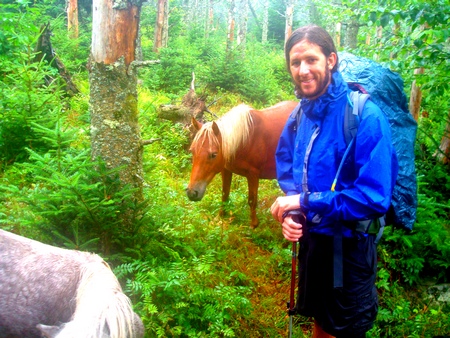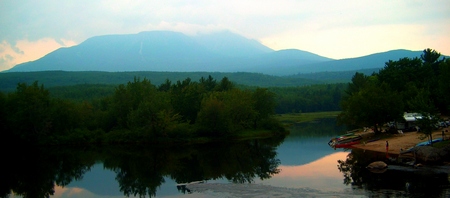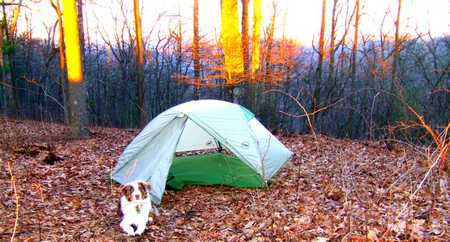Guest Post by Stratton Lawrence
 There's much to be said for the old Boy Scout maxim, "Be Prepared." But being prepared doesn't necessarily mean that you've got every piece of gear in your pack you could ever need. Sure, it would be nice to have an ax when you're 50 miles into the 100-Mile Wilderness and wanting to build a fire, but carrying the ax may actually leave you less prepared for the 5,000 feet of elevation change that you plan to traverse the following morning.
There's much to be said for the old Boy Scout maxim, "Be Prepared." But being prepared doesn't necessarily mean that you've got every piece of gear in your pack you could ever need. Sure, it would be nice to have an ax when you're 50 miles into the 100-Mile Wilderness and wanting to build a fire, but carrying the ax may actually leave you less prepared for the 5,000 feet of elevation change that you plan to traverse the following morning.
Figuring out the give-and-take of what's appropriate to bring along on an extended trip is always a work in progress, but it's one where paying attention to those who have gone before can truly payoff. That holds especially true when preparing for wet weather conditions in the wilderness. Nothing spoils a trip faster (or forces a premature return home) than extreme discomfort caused by wet conditions.
Despite a childhood spent backpacking and traveling (including several Scout weekends spent hunkered down in driving tempests), I've still had to learn a few of these lessons the hard way. Even worse, I've watched fellow travelers that I'm responsible for ignore my admonitions, leaving me to pick up their slack (or carry their stuff) when the going gets tough enough to prove me right.
Here are a handful of my most memorable learning moments when it comes to staying dry outside:
1. Keep Your Sleeping Bag Dry (at all cost!)
 Remember the soldiers' adage to "keep your powder dry?" The same goes for your camping gear.
Remember the soldiers' adage to "keep your powder dry?" The same goes for your camping gear.
Hiking in the rain can be fun. Honestly, I enjoy the closeness and personal reflection that comes with walking through a downpour or a constant mist -- there's less to see and it's more difficult to converse with fellow travelers, so it's a chance to focus on each step.
That said, part of the fun is knowing that at the end of the day, I have a warm, dry sleeping bag to slide into. Without that assurance, hiking in the rain can be miserable.
The take away? Always put a plastic trash bag into your sleeping bag stuff sack, and stuff the bag into that. In addition, use a large bag inside of your pack. It's a simple and inexpensive step, and it's more effective than expensive pack covers for keeping water out.
While leading a wilderness trip in Maine in 2006 with 10 high school aged students, one 13-year-old ignored me on this point (I was even providing the bags). Of course, the trip leader (me) got to sleep with a sopping wet bag that night, and I learned my lesson to double-check my fellow hikers packs as well.
2. Ditch the Sponges
Along the same lines, cotton is generally smart to avoid while traveling. Before stuffing your gear into your pack, lay everything out and consider what the heaviest items are and whether or not they are necessary.
On the same trip in Maine, I audited each of my campers' packs before hitting the trail, removing blue jeans and any other cotton clothing that could potentially soak up water and not dry in wet conditions. One student (a different one than before) snuck his jeans back into his pack -- a decision he regretted four days later when he wasn't allowed to leave them (soaking wet) by the side of the trail.
3. Tarp Smart
Most quality backpacking tents now include the option of a footprint that protects the tent floor, as well as providing an extra waterproof layer between sleeping pads and wet dirt. Many people, however, still utilize a thicker tarp, especially when car camping. It's a great option, but it can backfire if the tarp is allowed to overlap the bottom of the tent.
Why? Because creating a waterproof layer underneath your tent loses its value if you funnel water on top of it. It seems like an obvious tip, but I've seen countless weekends ruined (mostly at music and arts festivals with novice campers) by forgetting to tuck a tarp's overlapping sections underneath the tent. Nobody wants a waterbed when they're camping.
4. Refresh Your Waterproofing
 Even the most high-end tents eventually lose their waterproofing capabilities, especially when they're stored rolled up in their bags for long periods of time. Fortunately, most of this can be restored. I use Nikwax products to restore the seals along my tent seams and coat my tent walls, but there are plenty of options on the market that work well.
Even the most high-end tents eventually lose their waterproofing capabilities, especially when they're stored rolled up in their bags for long periods of time. Fortunately, most of this can be restored. I use Nikwax products to restore the seals along my tent seams and coat my tent walls, but there are plenty of options on the market that work well.
Once a year, make a point to set up your tent and give it a waterproofing once-over. You'll be grateful that you did the next time you're hunkered down in a three-day torrent. Nobody likes the phantom drip leaking through their tent wall!
5. Keep Lines Taut
It may look like the most beautiful clear night at sunset, but you never know when rain will roll in at 4 a.m. In the dark and amid heavy rain is not the time to secure your tent's rain fly. Take the extra three minutes to stake it out properly so that rain will funnel away from your tent instead of pooling up and dripping through.
6. Carry an Umbrella
When I first read Ray Jardine's "Beyond Backpacking," I scoffed at his strong advice to carry an umbrella while hiking. It seemed like extra weight. But in fact, an 8-ounce model can pay for itself in weight by replacing a rain jacket and sunscreen. I'm now a convert, and am grateful for Francis articulating the many reasons it's a worthwhile addition to your gear!
What's your worst rain-related camping or travel story? Have you ever had to come home early due to ill preparedness for wet weather?
Stratton Lawrence is a freelance travel writer and all around outdoor adventurer. Stratton covers a variety of outdoors related topics for eBay.com.



